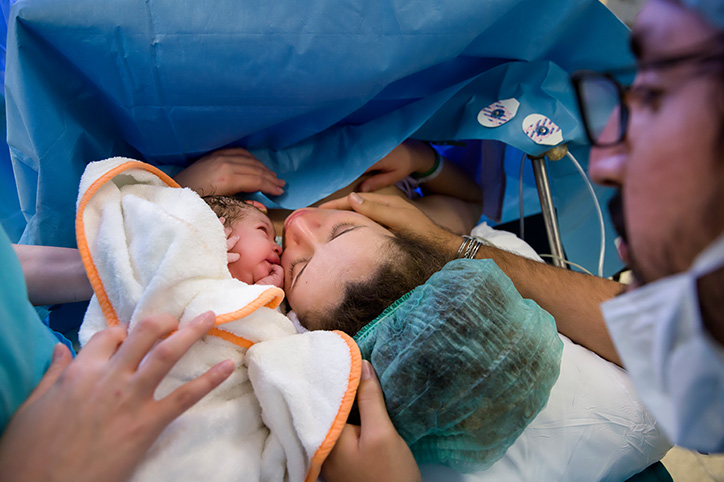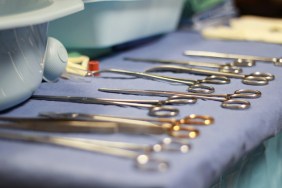At 39-weeks pregnant, Julie Janzen believed that her pregnancy would be uneventful and ordinary. Dramatics have a place in all of our lives that we, as humans, eagerly welcome and immensely enjoy. However, when it comes to giving birth, we want the same tune, different verse; we want to fit blissfully into the tale as old as time, and we do not want to be any kind of exception.
Some exceptions are positive, of course, but bringing life into this world is challenging enough.
Julie Janzen’s uneventful pregnancy took a dramatic turn when she was diagnosed with a life-threatening aortic dissection at 39-weeks. Her care team quickly convened to develop a plan to save the lives of Julie and her baby. https://t.co/jKzX83xSs5
— MayoClinicHealthSystem (@MayoClinicHS) September 23, 2021
A Day Unlike Any Other
It was May, the 5th, and Janzen went to work, per usual, with plans to attend a local fire department fundraiser with her husband, Kyle Janzen, that evening. Her pregnancy, thus far, had progressed beautifully, without incident. Not even morning sickness.
However, while attending the fundraiser, something dramatically shifted.
“My vision blurred, and I had a strong pain in my upper chest. At first, I thought I swallowed wrong,” Janzen retold. Unsure of what was happening, the Janzens sought out the event’s volunteer EMT, who checked her vitals and reported that while they were strong, her pupils were dilated.
On recommendation from the EMT, the Janzens made haste to the Mayo Clinic Health System in Eau Claire, Wisconsin, where they were attended to by Carla Williams, M.D., the OB-GYN on call that evening.
Critical Care Unit
Dr. Williams was able to determine that Janzen wasn’t in labor and her vital signs were normal, but since the pain persisted, and her oxygen saturation levels would drop after a few steps, she ordered an echocardiogram; which revealed a rare, and life-threatening, aortic dissection.
“An aortic dissection is an extremely dangerous acute event with high fatality rates,” Nishant Saran, M.B.B.S., a cardiovascular surgeon, told La Crosse. “There is also a huge risk that the aorta itself may rupture, leading to almost instant death.”
“With this condition, about 80% of people never make it to the hospital,” furthered Robert Wiechmann, M.D., a Mayo Clinic Health System cardiovascular surgeon. “For the rest, every hour that passes, the risk of death goes up 10%. We needed to act immediately.”
Zero to 100, to Save Both Lives
In order to save both Julie Janzen, and her baby, two surgeries would need to take place; one to safely deliver the child, and another to repair Janzen’s aorta. However, performing these surgeries successively presented multiple challenges.
For one, routine heart surgeries require the steady administration of anticoagulation medications to thin the blood and prevent clots. However, in Janzen’s case, this wouldn’t be possible, due to one of the back-to-back surgeries being a cesarean section (c-section), where the risk of blood loss is too great.
Westley Manske, D.O., a Mayo Clinic Health System anesthesiologist, explained that blood pressure management was the other significant challenge. Normally, Janzen’s blood pressure would have been lowered, “preventing worsening of the dissection or rupture,” Dr. Manske explained, “But since she was pregnant, lowering it too far could be dangerous for the baby.”
Creative thinking, ended up providing a solution, “We chose a special opiate medication not normally used for this type of surgery that helped with her blood pressure and rapidly wore off so the baby would not experience any adverse effects from a longer-acting opiate medication,” relayed Dr. Manske.
Quick & Creative Planning Equals Successful Delivery
On the morning of May 6th, following an emergency c-section riddled with challenges, Dr. Williams helped Julie Janzen deliver a healthy baby boy, Logan—8 pounds, 14 ounces.
“Everyone gave a sigh of relief to hear the baby cry,” says Mark Twesme, a cardiovascular surgery physician assistant.
But Julie Janzen wasn’t out of the woods yet.
A 12-Hour Surgery After Giving Birth
Immediately after giving birth, Janzen underwent a 12-hour heart surgery to replace her dissected aorta with a replacement graft, or a synthetic tube meant to simulate the aorta’s critical role in heart function.
To successfully make this replacement, the surgeons would have to cool her body, stop her heart entirely, and work quickly through challenges that presented themselves throughout.
“In Julie’s case, the aorta was torn all the way down to the aortic valve and she had tears into the major vessels going to the right arm and brain. All of this needed to be reconstructed,” explained Dr. Wiechmann. “It was very challenging. There is no routine dissection repair surgery, since each one is different. In these cases, surgeons have to take their skill sets and adapt them to the unique situation.”
A Miracle of Minds & Collaboration
Without the quick thinking of several medical professionals, starting with the EMT that noticed a simple pupil dilation and likely saved two lives in doing so, May 5th would have been a very different day for the Janzens.
Moving forward from this day, Julie Janzen did have a few setbacks, which included an additional heart surgery to repair unexpected damage from the first, but the miracle of minds monitoring her was able to address that issue, as well.
“Even today, I can’t believe everything that happened,” says Julie Janzen,“ The medical staff ― the entire team ― all were phenomenal. They did an amazing job.”
You can read Julie Janzen’s full story on the Mayo Clinic Health System‘s website here.
How does this story make you feel? If this was you, what would you have to say to these life-saving medical professionals? Let us know in the comments below.








